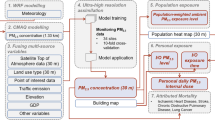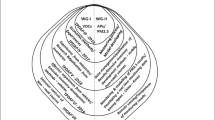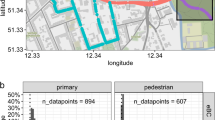Abstract
Air pollution is a major environmental and health problem, especially in urban agglomerations. Estimating personal exposure to fine particulate matter (PM2.5) remains a great challenge because it requires numerous point measurements to explain the daily spatial variation in pollutant levels. Furthermore, meteorological variables have considerable effects on the dispersion and distribution of pollutants, which also depends on spatio-temporal emission patterns. In this study we developed a hybrid interpolation technique that combined the inverse distance-weighted (IDW) method with Kriging with external drift (KED), and applied it to daily PM2.5 levels observed at 10 monitoring stations. This provided us with downscaled high-resolution maps of PM2.5 for the Island of Montreal. For the KED interpolation, we used spatio-temporal daily meteorological estimates and spatial covariates as land use and vegetation density. Different KED and IDW daily estimation models for the year 2010 were developed for each of the six synoptic weather classes. These clusters were developed using principal component analysis and unsupervised hierarchical classification. The results of the interpolation models were assessed with a leave-one-station-out cross-validation. The performance of the hybrid model was better than that of the KED or the IDW alone for all six synoptic weather classes (the daily estimate for R2 was 0.66–0.93 and for root mean square error (RMSE) 2.54–1.89 μg/m3).
This is a preview of subscription content, access via your institution
Access options
Subscribe to this journal
Receive 6 print issues and online access
$259.00 per year
only $43.17 per issue
Buy this article
- Purchase on Springer Link
- Instant access to full article PDF
Prices may be subject to local taxes which are calculated during checkout






Similar content being viewed by others
References
Goverment of Canada Canadian Smog Science Assessment 2012, ISBN 978-1-100-19064-8: 64.
U.S. EPA. 2009 Final Report: Integrated Science Assessment for Particulate Matter. U.S. Environmental Protection Agency, Washington, DC, EPA/600/R-08/139F, 2009.
Zanobetti A, Schwartz J . The effect of fine and coarse particulate air pollution on mortality: a national analysis. Environ Health Perspect 2009; 117: 898–903.
Ito K, Mathes R, Ross Z, Nádas A, Thurston G, Matte T . Fine particulate matter constituents associated with cardiovascular hospitalizations and mortality in New York City. Environ Health Perspect 2011; 19: 467–473.
Bell M, Ebisu K, Peng R, Walker J, Samet J, Zeger S et al. Seasonal and regional short-term effects of fine particles on hospital admissions in 202 US counties, 1999–2005. Am J Epidemiol 2008; 168: 1301–1310.
Goldman G, Mulholland J, Russell A, Gass K, Strickland M, Tolbert P . Characterization of ambient air pollution measurement error in a time-series health study using a geostatistical simulation approach. Atmos Environ 2012; 57: 101–108.
Brauer M, Hoek G, van Vliet P, Meliefste K, Fischer P, Gehring U et al. Estimating long-term average particulate air pollution concentrations: application of traffic indicators and geographic information systems. Epidemiology 2003; 14: 228–239.
Pinto J, Lefohn A, Shadwick D . Spatial variability of PM2.5 in urban areas in the United States. J Air Waste Manag Assoc 2012; 54: 440–449.
Dawson JP, Adams PJ, Pandis SN . Sensitivity of PM2.5 to climate in the Eastern US: a modeling case study. Atmos Chem Phys 2007; 7: 4295–4309.
Munoz-Alpizar R, Blanchet J . Application of the NARCM model to high-resolution aerosol simulations: case study of Mexico City basin during the Investigacion sobre Materia Particulada y Atmosférico-Aerosol and Visibility Research measurements campaign. J Geophys Res 2003; 108: 14.
Tai APK, Mickley LJ, Jacob DJ . Correlations between fine particulate matter (PM2.5) and meteorological variables in the United States: implications for the sensitivity of PM2.5 to climate change. Atmos Environ 2010; 44: 3976–3984.
Malek E, Davis T, Martin R, Silva P . Meteorological and environmental aspects of one of the worst national air pollution episodes (January, 2004) in Logan, Cache Valley, Utah, USA. Atmos Res 2006; 79: 108–112.
Lipsett MJ, Ostro BD, Reynolds P, Goldberg D, Hertz A, Jerrett M et al. Long-term exposure to air pollution and cardiorespiratory disease in the California teachers study Cohort. Am J Respir Crit Care Med 2011; 184: 828–835.
Henderson S, Beckerman B, Jerrett M, Brauer M . Application of land use regression to estimate long-term concentrations of traffic-related nitrogen oxides and fine particulate matter. Environ Sci Technol 2007; 41: 2422–2428.
Briggs DJ, Collins S, Elliott P, Fischer P, Kingham S, Lebret E et al. Mapping urban air pollution using GIS: a regression-based approach. Int J Geogr Inf Sci Total Environ 1997; 11: 699–718.
Adam-Poupart A, Brand A, Fournier M, Jerrett M, Smargiassi A . Spatiotemporal modeling of ozone levels in Quebec (Canada): a comparison of kriging, land-use regression (LUR), and combined bayesian maximum entropy–LUR approaches. Environ Health Perspect 2014; 122: 970–976.
Beckerman B, Jerrett M, Serre M, Martin R, Lee S, Van Donkelaar A et al. A hybrid approach to estimating national scale spatiotemporal variability of PM2.5 in the contiguous United States. Environ Sci Technol 2013; 47: 7233–7241.
Jerrett M, Burnett R, Goldberg M, Sears M, Krewski D, Catalan R et al. Spatial analysis for environmental health research: concepts, methods, and examples. J Toxicol Environ Health 2003; 66: 1783–1810.
Chen C, Wu C, Yu H, Chan C, Cheng T . Spatiotemporal modeling with temporal-invariant variogram subgroups to estimate fine particulate matter PM2.5 concentrations. Atmos Environ 2012; 54: 1–8.
Pearce JL, Rathbuna SL, Aguilar-Villalobos M, Naeher LP . Characterizing the spatiotemporal variability of PM2.5 in Cusco, Peru using kriging with external drift. Atmos Environ 2009; 43: 2060–2069.
RSQA. Environmental Assessment Report–Air Quality of Montreal. Ville de Montréal–Direction de l'environnement et du Développement Durable, 2010.
Environment Canada. National Air Pollution Surveillance Network (NAPS) Data Products, 2013. Available at http://maps-cartes.ec.gc.ca/rnspa-naps/data.aspx. Accessed 10 March 2013.
Canadian Council of Ministers of the Environment Ambient air monitoring protocol for PM2.5 and ozone | Canada-wide standards for particulate matter and ozone. 2011; 978-1-896997-99-5 PDF: 61.
Environment Canada. Canada National Climate Data and Information Archive, 2013. Available at http://climate.weather.gc.ca/index_e.html. Accessed 5 March 2013.
Environment Canada. Major smog episodes, 2014. Available at http://www.ec.gc.ca/info-smog/default.asp?lang=En&n=669E620B-1. Accessed 20 January 2014.
Hufty A . Analyse en composants principales des situations synoptiques au Québec. Géographie physique et Quaternaire 1982; XXXVI: 307–314.
Rose N, Cowie C, Gillett R, Marks G . Weighted road density: a simple way of assigning traffic-related air pollution exposure. Atmos Environ 2009; 43: 5009–5014.
Hansell AL, Rose N, Cowie CT, Belousova EG, Bakolis I, Ng K et al. Weighted road density and allergic disease in children at high risk of developing asthma. PLoS One 2014; 9: 9.
Su J, Jerrett M, Beckerman B . A distance-decay variable selection strategy for land use regression modeling of ambient air pollution exposures. Sci Total Environ 2009; 407: 3890–3898.
Zou B, Wilson JG, Zhan FB, Zeng Y . An emission-weighted proximity model for air pollution exposure assessment. Sci Total Environ 2009; 407: 4939–4945.
Ross Z, Jerrett M, Ito K, Tempalski B, Thurston G . A land use regression for predicting fine particulate matter concentrations in the New York City region. Atmos Environ 2007; 41: 2255–2269.
Brauer M, Lencar C, Tamburic L, Koehoorn M, Demers P, Karr C . A cohort study of traffic-related air pollution impacts on birth outcomes. Environ Health Perspect 2008; 116: 680–686.
Statistics Canada. Dissemination Area (DA), 2009. Available at http://www12.statcan.ca/census-recensement/2006/ref/dict/geo021-eng.cfm. Accessed 10 April 2012.
Hoek G, Beelen R, De Hoogh K, Vienneau D, Gulliver J, Fischer P et al. A review of land-use regression models to assess spatial variation of outdoor air pollution. Atmos Environ 2008; 42: 7561–7578.
Nowak D, Hirabayashi S, Bodine A, Hoehn R . Modeled PM2.5 removal by trees in ten U.S. cities and associated health effects. Environ Poll 2013; 178: 395–402.
The tasseled Cap - A graphic description of the spectral-temporal development of agricultural crops as seen by LANDSAT. Symposium on Machine Processing of Remote Sensed Data; West Lafayette, Indiana. Institute of Electrical and Electronics Engineers, Inc. (IEEE), 1976.
Su J, Jerrett M, Beckerman B, Verma D, Arain MA, Kanaroglou P et al. A land use regression model for predicting ambient volatile organic compound concentrations in Toronto, Canada. Atmos Environ 2010; 44: 3529–3537.
Markevych I, Fuertes E, Tiesler C, Birk M, Bauer C, Koletzko S et al. Surrounding greenness and birth weight: results from the GINIplus and LISAplus birth cohorts in Munich. Health Place 2014; 26: 39–46.
Wackernagel H . Multivariate Geostatistics: an Introduction with Applications. Springer: Berlin, Heidelberg. 2003.
Stein A, Van der Meer F, Gorte B . Spatial statistic for remote sensing. Kluwer Academic Publishers: Dordrecht, The Netherlands, 1999, pp 284.
Matheron G. . Le krigeage universel. In: ENSMP (ed). Les Cahiers du Centre de Morphologie Mathématique de Fontainebleau. École Nationale Supérieure des Mines de Paris: France, 1969, pp 1-83.
Chiles JP . Application du krigeage avec dérive externe à l'implantation d'un réseau de surveillance piézométrique. Sciences de la Terre 1991; 30: 131–147.
Goovaerts P . Geostatistics for Natural Resources Evaluation. Oxford University Press: New York, USA. 1997.
Al-Hamdan MZ, Crosson WL, Limaye AS, Rickman DL, Quattrochi DA, Estes MG et al. Methods for characterizing fine particulate matter using ground observations and remotely sensed data: potential use for environmental public health surveillance. J Air Waste Manag Assoc 2009; 59: 865–881.
Hystad P, Demers P, Johnson K, Brook J, Van Donkelaar A, Lamsal L et al. Spatiotemporal air pollution exposure assessment for a Canadian population-based lung cancer case-control study. Environ Health 2012; 11: 1–13.
Beelen R, Hoek G, Pebesma E, Vienneau D, De Hooghd K, Briggs DJ . Mapping of background air pollution at a fine spatial scale across the European Union. Sci Total Environ 2009; 407: 1852–1867.
Yu H, Chen J, Christakos G, Jerrett M . BME estimation of residential exposure to ambient PM10 and ozone at multiple time scales. Environ Health Perspect 2009; 110: 537–544.
Kwan M-P . From place-based to people-based exposure measures. Soc Sci Med 2009; 69: 1311–1313.
Kwan M-P . The uncertain geographic context problem. Ann Assoc Am Geogr 2012; 102: 958–968.
Acknowledgements
The authors would like to acknowledge Allan Brand for providing a compilation of meteorological and ground-level PM2.5 data for this study. We also thank Éric de Montigny for comments on an earlier version of this paper. This project was financially supported by the Quebec Institute of Public Health.
Author information
Authors and Affiliations
Corresponding author
Ethics declarations
Competing interests
The authors declare no conflict of interest.
Rights and permissions
About this article
Cite this article
Ramos, Y., St-Onge, B., Blanchet, JP. et al. Spatio-temporal models to estimate daily concentrations of fine particulate matter in Montreal: Kriging with external drift and inverse distance-weighted approaches. J Expo Sci Environ Epidemiol 26, 405–414 (2016). https://doi.org/10.1038/jes.2015.79
Received:
Revised:
Accepted:
Published:
Issue Date:
DOI: https://doi.org/10.1038/jes.2015.79
Keywords
This article is cited by
-
A Review of Air Quality Modeling
MAPAN (2020)



